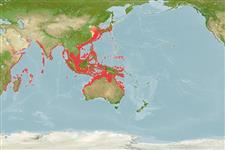Klassifizierung / Names
Namen | Synonyme | Catalog of Fishes (gen., sp.) | ITIS | CoL | WoRMS | Cloffa
Actinopterygii (Strahlenflosser) >
Perciformes (Perch-likes) >
Scombridae (Mackerels, tunas, bonitos) > Scombrinae
Etymology: Thunnus: Greek, thynnos = tunna (Ref. 45335).
Lebensraum / Klimazone / Range
Ökologie
; seewasser; ozeanodrom (Ref. 51243); tiefenbereich 10 - ? m. Tropical, preferred 28°C (Ref. 107945); 47°N - 31°S, 34°E - 154°E (Ref. 54923)
Indo-West Pacific: Red Sea and East Africa to New Guinea, north to Japan, south to Australia. Reported in New Zealand (Ref. 89192).
Size / Gewicht / Alter
Maturity: Lm ? range ? - ? cm
Max length : 145 cm FL Männchen/unbestimmt; (Ref. 40637); common length : 70.0 cm FL Männchen/unbestimmt; (Ref. 168); max. veröff. Gewicht: 35.9 kg (Ref. 168)
Wirbelzahl: 39. A small species, deepest near the middle of the first dorsal fin base. The second dorsal fin is higher than the first dorsal fin; the pectoral fins are short to moderately long; swim bladder is absent or rudimentary. Lower sides and belly silvery white with colorless elongate oval spots arranged in horizontally oriented rows. The dorsal, pectoral and pelvic fins are blackish; the tip of the second dorsal and anal fins are washed with yellow; the anal fin is silvery; the dorsal and anal finlets are yellow with grayish margins; the caudal fin is blackish, with streaks of yellow green.
Predominantly neritic species avoiding very turbid waters and areas with reduced salinity such as estuaries. May form schools of varying size. Feeds on a variety of fishes, cephalopods, and crustaceans, particularly stomatopod larvae and prawns (Ref. 9684). Marketed mainly fresh and dried salted (Ref. 9684), but also smoked, canned and frozen (Ref. 9987).
Life cycle and mating behavior
Geschlechtsreife | Fortpflanzung | Ablaichen | Eier | Fecundity | Larven
Collette, B.B. and C.E. Nauen, 1983. FAO Species Catalogue. Vol. 2. Scombrids of the world. An annotated and illustrated catalogue of tunas, mackerels, bonitos and related species known to date. Rome: FAO. FAO Fish. Synop. 125(2):137 p. (Ref. 168)
IUCN Rote Liste Status (Ref. 115185)
CITES (Ref. 94142)
Not Evaluated
Bedrohung für Menschen
Harmless
Nutzung durch Menschen
Fischereien: hoch kommerziell; Sportfisch: ja
Mehr Information
NamenSynonymeMetabolismusRäuberÖkotoxikologieFortpflanzungGeschlechtsreifeAblaichenFecundityEierEientwicklung
Tools
Zusatzinformationen
Download XML
Internet Quellen
